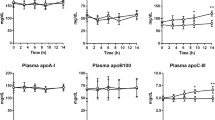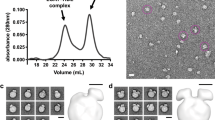Abstract
BROWN and Goldstein1,2 have shown that when cultured human fibroblasts are incubated in the presence of low density lipoprotein (LDL), they take up some LDL, the apoprotein of LDL (apoLDL) is catabolised and cholesterol synthesis is inhibited. Experiments on the uptake of LDL as a function of LDL concentration have led to the conclusion1,2 that normal fibroblasts have genetically controlled surface receptors with high affinity for apoLDL and that uptake of LDL by the receptors is essential for the regulation of cholesterol synthesis. These findings raise the possibility that receptor-mediated uptake by fibroblasts, and perhaps by other cells3,4, has an important role in the regulation of apoLDL catabolism and of cholesterol synthesis in vivo. But the concentration of LDL protein required to saturate the LDL receptors on cultured fibroblasts (about 50 µg ml−1) is less than half the probable concentration in interstitial fluid5. Moreover, whereas cultured fibroblasts from patients with familial hypercholesterolaemia (FH) in the homozygous form synthesise cholesterol at 50 times the normal rate, the rate of synthesis of cholesterol in the whole bodies of FH patients is usually normal6 or subnormal7. For these reasons it seemed desirable to study the binding and catabolism of LDL by uncultured human cells. We used circulating lymphocytes because they can be obtained readily and repeatedly from healthy human subjects. Our results show that uncultured lymphocytes exhibit high capacity surface binding of LDL, but the binding curves show no evidence for the presence of high affinity receptors for LDL.
This is a preview of subscription content, access via your institution
Access options
Subscribe to this journal
Receive 51 print issues and online access
$199.00 per year
only $3.90 per issue
Buy this article
- Purchase on Springer Link
- Instant access to full article PDF
Prices may be subject to local taxes which are calculated during checkout
Similar content being viewed by others
References
Brown, M. S., and Goldstein, J. L., Proc. natn. Acad. Sci. U.S.A., 71, 788–792, (1974).
Goldstein, J. L., and Brown, M. S., J. biol. Chem., 249, 5153–5162, (1974).
Goldstein, J. L., and Brown, M. S., Archs Pathol., 99, 181–184 (1975).
Kayden, H. J., Hatam, L., Beratis, N., and Hirschhorn, K., Clin. Res., 23, 398a (1975).
Reichl, D., Simons, L. A., Myant, N. B., Pflug, J. J., and Mills, G. L., Clin. Sci. molec. Med., 45, 313–329, (1973).
Grundy, S. M., Ahrens, E. H., Jr, and Salen, G., J. lab. clin. Med., 78, 94–121, (1971).
Miettinen, T. A., Ann. clin. Res., 2, 300–320, (1970).
Böyum, A., Scand. J. clin. lab. Invest., 21, Suppl. 97, 31–50, (1968).
Havel, R. J., Eder, H. A., and Bragdon, J. H., J. clin. Invest., 34, 1345–1353, (1955).
Bilheimer, D. W., Eisenberg, S., and Levy, R. I., Biochim. biophys. Acta, 260, 212–221. (1972).
Bierman, E. L., Stein, O., and Stein, Y., Circulation Res., 35, 136–150, (1974).
Goldstein, J. L., Basu, S. K., Brunschede, G. Y., and Brown, M. S., Cell (in the press).
Author information
Authors and Affiliations
Rights and permissions
About this article
Cite this article
REICHL, D., POSTIGLIONE, A. & MYANT, N. Uptake and catabolism of low density lipoprotein by human lymphocytes. Nature 260, 634–635 (1976). https://doi.org/10.1038/260634a0
Received:
Accepted:
Issue Date:
DOI: https://doi.org/10.1038/260634a0
This article is cited by
-
Cholesterol synthesis in freshly isolated human leukocytes
Experientia (1977)
Comments
By submitting a comment you agree to abide by our Terms and Community Guidelines. If you find something abusive or that does not comply with our terms or guidelines please flag it as inappropriate.



